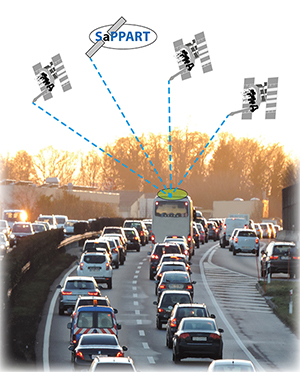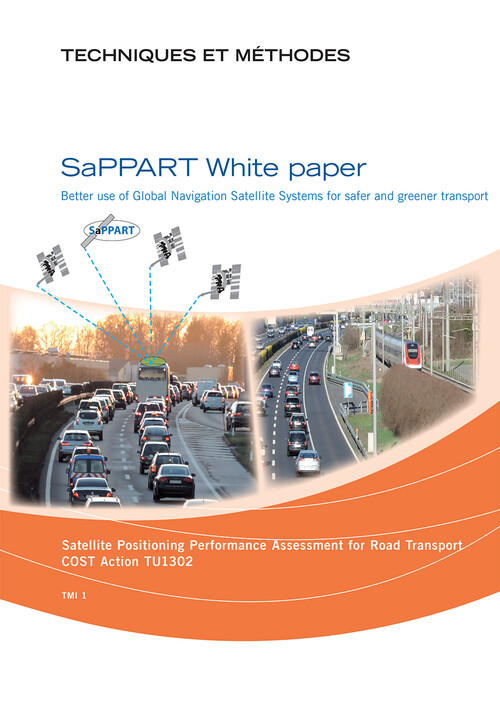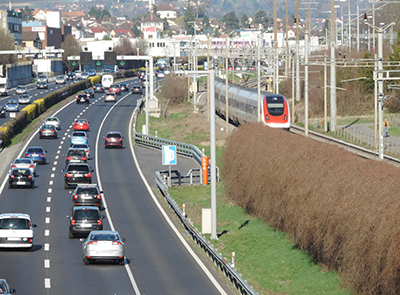SaPPART White paper
COST Action TU1302
For a better use of Global Navigation Satellite Systems for safer and greener transport.

The book in a few words
Effective transportation of people and goods requires an efficient positioning service. This service currently relies mainly on Global Navigation Satellite System (GNSS).
Due to the physical principle of satellite based position determination, the level of performance delivered by any terminal using GNSS highly depends on the conditions it is used in. These influencing conditions are primarily due to the physical features in the built and natural environments around the antenna, which have a strong impact on the propagation of radio-waves. Furthermore, the problem of intentional and unintentional signal interference is a major concern.
Depending on the type of application and positioning requirements, the current GNSS deficiencies can be overcome by hybridization with other positioning sensors and digital spatial data.
In the case of critical applications, the actual performance of the positioning terminal should be determined in terms of availability, accuracy and integrity.
Intelligent transport systems (ITS) stakeholders expressed the need of standardized performance metrics for positioning terminals and the associated performance assessment procedures.These issues have been addressed by the SaPPART COST action, a European network of experts in GNSS, ITS and mobility. Three deliverables have been produced on these topics.
- The white paper introduces the fundamentals of positioning systems, with the focus on GNSS, explaining their role in transportation and stressing the importance of a reliable assessment of their performance.
- The handbook is dedicated to performance issues and the principles for performance assessment of GNSS-based positioning terminals are presented.
- The guidelines provides guidelines for test procedures for the performance assessment of GNSS-based positioning terminals, either by field tests, simulations or their combination
To know more about the book
- François Peyret
- Pierre-Yves Gilliéron
- Laura Ruotsalainen
- Jesper Engdahl
- David Bétaille, Institut français des sciences et technologie des transports, de l’aménagement et des réseaux (Ifsttar), France
- Philippe Bonnifait, Université de Technologie de Compiègne (UTC), France
- Nuria Blanco Delgado, European Satellite Services Provider (ESSP), Spain
- Joaquin Cosmen Schortmann, GMV, Spain
- Jesper Engdahl, Rapp Trans SA, Switzerland
- Vasillis Gikas, National Technical University of Athens, Greece
- Pierre-Yves Gilliéron, École polytechnique fédérale de Lausanne (EPFL), Switzerland
- Michal Hodon, Faculty of Management Science and Informatics, Slovakia
- Shaojun Feng, Imperial College, United Kingdom
- Juraj Machaj, University of Zilina, Slovakia
- Juliette Marais, Institut français des sciences et technologie des transports, de l’aménagement et des réseaux (Ifsttar), France
- Washington Ochieng, Imperial College, United Kingdom
- François Peyret, Institut français des sciences et technologie des transports, de l’aménagement et des réseaux (Ifsttar), France
- Laura Ruotsalainen, Finnish Geospatial Research Institute, National Land Survey (FGI NLS), Finland Robin Schubert, BASELABS, Germany
- Marko Sevrovic, University of Zagreb, Croatia
- Rafael Toledo Moreo, Universidad Politécnica de Cartagena, Spain
This white paper, entitled “Better use of Global Navigation Satellite Systems for safer and greener transport”, explains the role of positioning systems in transportation and the necessity to correctly assess their performance. This document introduces the fundamentals of positioning systems with a particular focus on GNSSs. It describes the positioning terminal architecture and the parameters used for the characterization of performance such as availability, accuracy and integrity. The goal of this white paper is to inform the key actors of the terrestrial transport sector on the issues and the impacts of positioning quality in applications, more specifically in Intelligent Transport Systems.
- Table of contents
- Executive summary
- Introduction
- Chapter 1. Positioning-based systems in transport
- Chapter 2. GNSS-based positioning technologies for transport
- Chapter 3. How to handle positioning performances
- List of acronyms
- List of figures
COST Action TU1302. SaPPART White paper: Better use of Global Navigation Satellite Systems for safer and greener transport. Ifsttar, 2015. techniques et méthodes, TMI 1. 58p. ISBN 978-2-85782-707-8.
Identity card of the book
| Title: | SaPPART white paper: Better use of Global Navigation Satellite Systems for safer and greener transport |
| Author: | COST Action TU1302 |
| Publisher: | IFSTTAR |
| Collection: | The IFSTTAR's collections |
| Reference: | TMI1 |
| ISBN: | 978-2-85782-707-8 |
| Edition: | Pdf file, free download |
| License: | CC BY-NC-ND 4.0 |
| Publication date: | Published in september 2015 |
| Number of pages: | 58 pages |
| Language: | English |
| Key words: | positioning, GNSS, integrity, road transport, intelligent transport systems |
| Contact: | librairie(at)univ-eiffel.fr |




![[Translate to English:] Licence creative commons BY-SA 4.0 [Translate to English:] Licence creative commons BY-SA 4.0](https://reflexscience.univ-gustave-eiffel.fr/fileadmin/ReflexScience/Accueil/Logos/CCbySA.png)